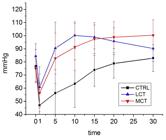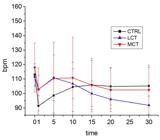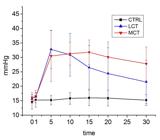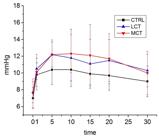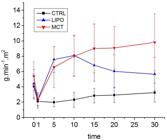Abstract
PURPOSE:
To compare the hemodynamic changes following two different lipid emulsion therapies after bupivacaine intoxication in swines.
METHODS:
Large White pigs were anesthetized with thiopental, tracheal intubation performed and mechanical ventilation instituted. Hemodynamic variables were recorded with invasive pressure monitoring and pulmonary artery catheterization (Swan-Ganz catheter). After a 30-minute resting period, 5 mg.kg-1 of bupivacaine by intravenous injection was administered and new hemodynamic measures were performed 1 minute later; the animals were than randomly divided into three groups and received 4 ml.kg-1 of one of the two different lipid emulsion with standard long-chaim triglyceride, or mixture of long and medium-chain triglyceride, or saline solution. Hemodynamic changes were then re-evaluated at 5, 10, 15, 20 and 30 minutes.
RESULTS:
Bupivacaine intoxication caused fall in arterial blood pressure, cardiac index, ventricular systolic work index mainly and no important changes in vascular resistances. Both emulsion improved arterial blood pressure mainly increasing vascular resistance since the cardiac index had no significant improvement. On the systemic circulation the hemodynamic results were similar with both lipid emulsions.
CONCLUSION:
Both lipid emulsions were efficient and similar options to reverse hypotension in cases of bupivacaine toxicity.
Anesthesia, Local; Bupivacaine; Fat Emulsions, Intravenous; Hemodynamics; Swine
Introduction
Local anesthetics (LA) are drugs commonly used in medical practice. Despite major
advances in pharmaceutical products and regional anesthesia techniques, adverse effects
such as overdose from intravascular injection still occur. Although local anesthetic
overdose is uncommon, severe toxicity is estimated at 0.075 to 0.2% in peripheral nerve
blocks and approximately 0.04% in epidural anesthesia11. Corcoran W, Butterworth J, Weller RS, Beck JC, Gerancher JC, Houle
TT, Groban L. Local anesthetic-induced cardiac toxicity: a survey of contemporary
practice strategies among academic anesthesiology departments. Anesth Analg. 2006
Nov;103(5):1322-6. PMID: 17056977. . Specific patient risk factors, concurrent medication use, block site and
technique, type and dose of local anesthetics, along with time for detection and
appropriateness of treatment, all influence the likelihood and severity of systemic
toxicity. Bupivacaine is currently the most widely used local anesthetic due to its
quality of anesthesia and prolonged action22. Groban L, Deal DD, Vernon JC, James RL, Butterworth J. Cardiac
resuscitation after incremental overdosage with lidocaine, bupivacaine,
levobupivacaine, and ropivacaine in anesthetized dogs. Anesth Analg. 2001
Jan;92(1):37-43. PMID: 11133597.
,
33. Chang DH-T, Ladd LA, Copeland S, Iglesias MA, Plummer JL, Mather LE.
Direct cardiac effects of intracoronary bupivacaine, levobupivacaine and ropivacaine
in the sheep. Br J Pharmacol. 2001.Feb;132(3):649-58. PMID: 11159717. . However, a 1979 issue of the journal
Anesthesiology44. Albright GA. Cardiac arrest following regional anesthesia with
etidocaine or bupivacaine. Anesthesiology. 1979;51(4):285-7. PMID: 484889. cited the severe
cardiovascular effects of accidental intravascular injection of bupivacaine, leading to
the search for newer less toxic agents with antidotes to counter their effects.
Bupivacaine intravascular injection may result in severe cardiovascular and neurologic
toxicity. Central nervous system toxicity precedes cardiovascular symptoms.
Manifestations of neurologic toxicity include tinnitus, metallic taste, visual
disturbances, perioral numbness, unconsciousness, seizures and coma. Cardiac toxicity is
characterized by decreased ventricular contractility, loss of vasomotor tonus,
cardiovascular collapse, dysrhythmia and asystole55. Leone S, Cianni SD, Casati A, Fanelli G. Pharmacology, toxicology,
and clinical use of new long acting long anesthetics, ropivacaine and
levopubivacaine. Acta Biomed. 2008 Aug;79(2):92-105. PMID: 18788503. . In an attempt to decrease these complications, safety measures such as
aspiration before local anesthetic injection, use of a test dose and epinephrine have
been adopted66. Mulroy MF. Systemic toxicity and cardiotoxicity from local
anesthetics: incidence and preventine measures. Reg Anesth Pain Med. 2002
Nov-Dec;27(6):556-61. PMID: 12430104. . In a review article from 1995,
Brown et al.77. Brown DL, Ransom DM, Hall JA, Schroeder DR, Offord KP. Regional
anesthesia and local anesthetic-induced systemic toxicity: seizure frequency and
accompanying cardiovascular changes. Anesth Analg. 1995 Aug;81(2):321-8. PMID:
7618723. reported that the
incidence of complications was 1.2 per 10,000 epidural anesthesias, obtaining a result
similar to that found by Auroy et al.88. Auroy Y, Narchi P, Messiah A, Litt L, Rouvier B, Samii K. Serious
complications related to regional anesthesia: results of a prospective survey in
France. Anesthesiology. 1997 Sep;87(3):479-86. PMID: 9316950. in France. Other long-acting local anesthetics expected to be safer
alternatives, e.g. ropivacaine and levobupivacaine were synthesized and launched on the
market99. Heavner JE. Local anesthetics. Curr Opin Anaesthesiol. 2007
Aug;20(4):336-412. PMID: 17620842. . Weinberg et al.1010. Weinberg GL, VadeBoncouer T, Ramaraju GA, Garcia-Amaro MF, Cwik MJ.
Pretreatment or resuscitation with a lipid infusion shifts the dose-response to
bupivacaine-induced asystole in rats. Anesthesiology. 1998 Apr;88(4):1071-5. PMID:
9579517. demonstrated that lipid emulsions (LE) used in
parenteral nutrition were efficient to decrease local anesthetic cardiotoxicity,
increasing the mean lethal bupivacaine dose by 50% in rats. Rosenblatt et
al.1111. Rosenblatt MA, Abel M, Fischer GW, Itzkovich CJ, Eisenkraft JB.
Successful use of a 20% lipid emulsion to resuscitate after a presumed
bupivacaine-related cardiac arrest. Anesthesiology. 2006 Jul;105(1):217-8. PMID:
16810015. and subsequently Litz
et al.1212. Litz RJ, Popp M, Stehr Sn, Koch T. Successful resuscitation of a
patient with ropivacaine-induced asystole after axilary plexus block using lipid
emulsion. Anaesthesia. 2006 Aug;61(8):800-1. PMID: 16867094. were the first
authors to publish the successful use of LE for treatment of cardiac arrest due to local
anesthetic toxicity in human. Since that time, the successful use of LE in the
management of local anesthetic toxicity has been reported1313. Warren JA, Thoma RB, Georgescu A, Shah SJ. Intravenous lipid
infusion in the successful resuscitation of local anesthetic-induced cardiovascular
collapse after supraclavicular brachial plexus block. Anesth Analg. 2008
May;106(5):1578-80. doi: 10.1213/01.ane.0000281434.80883.88.
https://doi.org/10.1213/01.ane.000028143...
,
1414. Dix SK, Rosner GF, Nayar M, Harris JJ, Guglin ME, Winterfield JR,
Xiong Z, Mudge GH Jr. Intractable cardiac arrest due to lidocaine toxicity
successfully resuscitated with lipid emulsion. Crit Care Med. 2011 Apr; 39(4):872-4.
doi: 10.1097/CCM.0b013e318208eddf.
https://doi.org/10.1097/CCM.0b013e318208...
. Several lipid preparations are available in
the market and have been used in-vivo and in-vitro
experiments. The source of lipids is the most significant difference between these
preparations. Solutions derived from soybean oil, containing long-chain triglycerides
(LCT), emulsions based on coconut oil and soybean oil (MCT) containing 50% medium-chain
and 50% long-chain triglycerides, and more recently solutions that also incorporate
olive oil and fish oil1515. Melo MDS, Bonfim MR, Dreyer E, Bassanezi BS, Udelsmann A.
Hemodynamic changes in lipid emulsion therapy (SMOFlipid) for bupivacaine toxicity in
swines. Acta Cir Bras. 2012 Apr;27(4):318-24. PMID: 22534807. are currently the most
widely used preparations. Each solution is of particular interest to parenteral
nutrition, although results are controversial in the management of local anesthetic
toxicity. According to some authors, LCT lipid emulsions is more effective1616. Mazoit JX, Le Guen R, Beloeil H, Benhamou D. Binding of long-lasting
local anesthetics to lipid emulsions. Anesthesiology. 2009 Feb;110(2):380-6. doi:
10.1097/ALN.0b013e318194b252.
https://doi.org/10.1097/ALN.0b013e318194...
,
1717. Li Z, Xia Y, Dong X, Chen H, Xia F, Wang X, Dong H, Jin Z, Ding X,
Papadimos TJ, Xu X. Lipid resuscitation of bupivacaine toxicity: long-chain
triglyceride emulsion provides benefits over long- and medium-chain triglyceride
emulsion. Anesthesiology. 2011 Dec;115(6):1219-28. doi:
10.1097/ALN.0b013e318238be73.
https://doi.org/10.1097/ALN.0b013e318238...
. Others believe that LCT is as efficient as
MCT1818. Candela D, Louart G, Bousquet PJ, Muller L, Nguyen M, Boyer JC,
Peray PA, Goret L, Ripart J, Lefrant JY, de La Coussaye JE. Reversal of
bupivacaine-induced cardiac eletrophysiologic changes by two lipid emulsions in
anesthetizes and mechanically ventilated piglets. Anesth Analg. 2010
May;110(5):1473-9. doi: 10.1213/ANE.0b013e3181d53c8d.
https://doi.org/10.1213/ANE.0b013e3181d5...
. Still other authors have found better
results with MCT emulsions1919. Ruan W, French D, Wong A, Drasner K, Wu AH. A mixed (long- and
medium-chain) triglyceride lipid emulsion extracts local anesthetic from human serum
in vitro more effectively than a long-chain emulsion. Anesthesiology. 2012
Feb;116(2):334-9. doi: 10.1097/ALN.0b013e318242a5f1.
https://doi.org/10.1097/ALN.0b013e318242...
. Lipid emulsions
have also been recently used in the treatment of toxicity due to several other
lipophilic drugs such as cyclic antidepressants, verapamil, β-blockers and barbiturates
among others2020. Cave G, Harvey M. Intravenous lipid emulsion as antidote beyond
local anesthetic toxicity: a systematic review. Acad Emerg Med. 2009
Sep;16(9):815-24. doi: 10.1111/j.1553-2712.2009.00499.x.
https://doi.org/10.1111/j.1553-2712.2009...
. The aim of this study was to
evaluate the hemodynamic results produced by management of bupivacaine toxicity in
swines, using two different lipid emulsions in our setting that contain different types
of triglycerides, in comparison to saline use.
Methods
The protocol was approved by the Institutional Animal Research Ethics Committee, State University of Campinas under number 2157-1.
Thirty pigs, weighing from 19.5 to 25 kg were fasted on the night before the experiment, with free access to water. On the morning of the study, animal weight was recorded, with estimation of body surface area2121. Holt JP, Rhode EA, Kines H. Ventricular volumes and body weigh in mammals. Am J Physiol 1968 Sep;215(3):704-15. PMID: 5671010. . Data was entered into the hemodynamic EngstronAS/3 monitor for calculation of hemodynamic indexes. A catheter was placed in the ear vein of the animal and anesthesia was induced with 25 mg.kg-1 of sodium thiopental. The animals were intubated, maintained under mechanical ventilation, using a mixture of air and O2 on a CO2 absorption circuit with tidal volume of 15 ml.kg-1 and respiratory rate adequate to achieve PETCO2 between 32 and 34 mmHg. Hemoglobin saturation was maintained >97% and measured by a probe placed on the animal tongue. A cardioscope was also used in a lead similar to DII. Maintenance of anesthesia was performed with isoflurane in O2 at an expired fraction of 1%. Local anesthesia was applied to the inner thigh of the animal unilaterally, using 5 ml of 1% lidocaine without vasopressor for dissection of the femoral artery and vein. Dissection was required for continuous monitoring of arterial blood pressure and insertion of a Swan-Ganz 7F catheter, which was located in a pulmonary artery branch identified by the morphology of the pressure curve obtained. Thirty minutes after a stabilization and resting period, the first baseline hemodynamic measurements (T0) were recorded: mean arterial pressure, heart rate, central venous pressure, mean pulmonary arterial pressure, pulmonary capillary pressure, cardiac index, systemic and pulmonary vascular resistance indexes, left and right ventricular systolic work indexes. Then intravenous bupivacaine was administered at a dose of 5 mg.kg-1. At one minute (T1) new hemodynamic parameters were recorded and the animals were randomly divided into three groups. In the first group, 4 ml.kg-1 of LCT were injected immediately after toxicity. In the second group, the same volume of MCT was injected. The third group, which was considered the control group (CTRL), received the same volume of saline infusion. New hemodynamic measurements were taken at five, 10, 15, 20 and 30 minutes (T5 to T30). To compare numerical variables between groups, the Kruskal-Wallis test was used. For comparison of longitudinal measurements between groups and time points, repeated measures ANOVA was used, followed by Tukey's multiple comparison test to compare groups at each time point and the contrast profile test to analyze the progress between evaluations in each group. The significance level adopted was 5%, or p<0.05.
Results
There were no significant differences between groups regarding weight, body surface area, or baseline hemodynamic parameters, as shown in Table 1.
Mean arterial blood pressure (MAP)
As shown in Figure 1, after bupivacaine injection a significant and similar MAP decrease occurred in all groups. T0 = T20 = T30 and T1<T5<T10<T15 in CTRL; T0 = T5 = T30 and T0<T10 a T20 in LCT; T0 = T5 and T0 < T10 to T30 in MCT (p<0.001). Among groups, there were no differences between MCT and LCT, but MCT > CTRL from T5 to T30 and LCT > CTRL from T5 to T20 (p<0.001).
Heart rate (HR)
Figure 2 shows that after bupivacaine injection in T1 there was a significant decrease in HR in all groups. In the CTRL group, all values remained lower than T0 values; T0=T5=T10 in the LCT and MCT groups, but all other values were lower than baseline values (p<0.001). There were no differences between LCT and MCT (p=0.814). However, CTRL<MCT in T1 and CTRL>LCT in T30 with no other differences between groups (p<0.001).
Central venous pressure (CVP)
Figure 3 shows that following toxicity, there was a significant and similar increase in CVP the three groups in T1. In CTRL and MCT, all other values remained higher than T0 values. In the LCT group, values were higher than T0 until T20 (p<0.001). There were no differences between LCT and MCT. However, CTRL<LCT in T5 and CTRL<MCT from T5 to T15 (p=0.023).
Mean pulmonary artery blood pressure (MPAP)
As shown in Figure 4, after bupivacaine injection there was no change in T1 in any group. In CTRL, all values remained similar to T0 value; in LCT and MCT, all values were higher than baseline values after T5. However, values decreased significantly after T10 in LCT. This was not observed in MCT, where values remained elevated, although there were no differences between LCT and MCT (p<0.001). After T5 in the CTRL group, values were all lower than in LCT and MCT. There were no significant differences between both groups (p<0.001).
Pulmonary capillary wedge pressure (PCWP)
Figure 5 shows that after intoxication, values increased significantly and similarly in the three groups. Values remained significantly elevated in the three groups until the end of the experiment, but T5>T1 (p<0.001) in both LCT and MCT. No differences between groups were observed (p=0.105).
Cardiac index (CI)
Figure 6 shows that after bupivacaine injection, PCWP decreased similarly in T1 in all groups persisting until the end of the experiment. There were no differences in time points between CTRL and LCT, while T20<T30 (p<0.001) in MCT. There were no differences among groups (p=0.454).
Systemic vascular resistance index (SVRI)
Figure 7 shows that after bupivacaine toxicity, SVRI did not change in T1 in any group. After T10 in CTRL, and T5 in LCT and MCT, the remaining values were all higher than To. T20>T30 (p<0.001) in LCT and MCT. There were no differences between LCT and MCT, but CTRL was <LCT from T5 to T15 and CTRL<MCT in T15 (p=0.032).
Pulmonary vascular resistance index (PVRI)
As shown in Figure 8, toxicity in T1 initially produced no change in any of the three groups. In CTRL, values remained unchanged until T30 with no significant differences. In contrast, lipid therapy with both agents provoked a significant increase in PVRI after T5. All values were higher than T0. In LCT, T10>T15 and T20>T30, while T20>T30 (p<0.001) in MCT. After T5, all LCT and MCT values were higher that CTRL values (p<0.001). However, there were no differences between LCT and MCT values.
Left ventricular stroke work index (LVSWI)
Figure 9 shows that bupivacaine toxicity produced a significant and similar decrease in LVSWI in T1 in the three groups. Subsequently, the CTRL group only recovered values similar to baseline values in T20, in addition to T1<T5=T10<T15=T20<T30; T0=T15 in LCT and T1<T5<T10; T0=T15 and T1<T5<T10<T15=T20<T30 in MCT (p<0.001). Among groups, there was no difference between LCT and MCT. However, CTRL<LCT from T5 to T15 and CTRL<MCT in T5 and T10 (p=0.017).
Right ventricular stroke work index (RVSWI)
Figure 10 shows that toxicity caused a similar fall in RVSWI in T1 in all groups. In the CTRL group, values remained lower than T0 until T15 and then achieved baseline values. In contrast, from T5 to T15 LCT values were higher than in T0 and then became equal; T0=T5 in MCT and the remaining values were all higher than baseline values (p<0.001). Between groups, significant differences were noted: CTRL<LCT and MCT from T5 to T30 and LCT<MCT in T20 and T30 (p=0.001).
Discussion
Locoregional anesthesia has aroused great interest in the past years. Concomitant
administration of locoregional anesthesia with general anesthesia in a multimodal
approach has enabled the use of significantly lighter planes of general anesthesia. It
is well-known that general anesthesia has negative cardiopulmonary repercussions.
However, local anesthetic cardiotoxicity in case of inadvertent intravascular injection
remains a concern for healthcare professionals, despite the implementation of newer
drugs and techniques used for neural blocks. In 2006, the use of lipid emulsions for
treatment of local anesthetic toxicity was proposed in humans. Three mechanisms were
proposed to explain the effects of these agents. The first mechanism suggests a
pharmacokinetic balance between the lipid plasma expansion phase, reducing the free
fraction of lipophilic drugs in the plasma, and hence toxicity. This effect known as the
"lipid sink" is obtained by chelation of LA molecules2222. Cave G, Harvey M. Intravenous lipid emulsion as antidote beyond
local anesthetic toxicity: a systematic review. Acad Emerg Med. 2009
Sep;16(9):815-24. doi: 10.1111/j.1553-2712.2009.00499.x.
https://doi.org/10.1111/j.1553-2712.2009...
which led to the use of this solution for treatment of toxicity from a
number of other lipophilic drugs. The second mechanism is based on the concept that
local anesthetics are known for inhibiting carnitine-acetyltransferase, essential for
the transportation of fatty acids into mitochondria2323. Chen Y, Xia Y, Liu L, Shi T, Shi K, Wang Q, Chen L, Papadimos TJ, Xu
X. Lipid emulsion reverses bupivacaine-induced asystole in isolated rat hearts.
Anesthesiology. 2010 Dec;113(6):1320-5. doi:
10.1097/ALN.0b013e3181fc63ed.
https://doi.org/10.1097/ALN.0b013e3181fc...
. LE could overcome this inhibition and metabolic effect of the toxic
substance through a "mass effect" alone or through another unknown mechanism. The third
mechanism is based on the known fact that fatty acids can increase calcium levels in
cardiac myocytes and may thus activate a direct inotropic route2222. Cave G, Harvey M. Intravenous lipid emulsion as antidote beyond
local anesthetic toxicity: a systematic review. Acad Emerg Med. 2009
Sep;16(9):815-24. doi: 10.1111/j.1553-2712.2009.00499.x.
https://doi.org/10.1111/j.1553-2712.2009...
,
2424. Aya AG, Ripart J, Sebbane MA, de La Coussaye JE. Lipid emulsions for
the treatment of systemic local anesthetic toxicity: efficacy and limits. Ann Fr
Anesth Reanim. 2010 Jun;29(6):464-9. doi:
10.1016/j.annfar.2010.03.020.
https://doi.org/10.1016/j.annfar.2010.03...
. The hypothesis that long-chain triglyceride
lipid emulsions in vitro would be more effective1616. Mazoit JX, Le Guen R, Beloeil H, Benhamou D. Binding of long-lasting
local anesthetics to lipid emulsions. Anesthesiology. 2009 Feb;110(2):380-6. doi:
10.1097/ALN.0b013e318194b252.
https://doi.org/10.1097/ALN.0b013e318194...
,
1717. Li Z, Xia Y, Dong X, Chen H, Xia F, Wang X, Dong H, Jin Z, Ding X,
Papadimos TJ, Xu X. Lipid resuscitation of bupivacaine toxicity: long-chain
triglyceride emulsion provides benefits over long- and medium-chain triglyceride
emulsion. Anesthesiology. 2011 Dec;115(6):1219-28. doi:
10.1097/ALN.0b013e318238be73.
https://doi.org/10.1097/ALN.0b013e318238...
motivated to conduct this study. The purpose
of the study was to evaluate hemodynamic repercussions in swines with
bupivacaine-induced toxicity and find the best solution in case this complication
occurred. In this experiment, we did not observe any significant differences in the main
hemodynamic variables using LE with long-chain triglycerides and a mixture of long-chain
and medium-chain triglycerides. Hemodynamic parameters improved secondary to increased
systemic vascular resistance and pulmonary vascular resistance in animals treated with
lipid emulsions, a result similar to that found by Stojiljkovic et
al.2525. Stojiljkovic MP, Zhang D, Lopes HF, Lee CG, Goodfriend TL, Egan BM.
Hemodynamic effects of lipids in humans. Am J Physiol Regul Integr Comp Physiol. 2001
Jun;280(6):R1674-9. PMID: 11353670. who studied hemodynamic
variations due to lipid infusion in humans, but contrary to Kearney et
al.2626. Kearney MT, Chowienczyk PJ, Brett SE, Sutcliffe A, Ritter JM, Shah
AM. Acute haemodynamic effects of lipolysis-induced increase of free fatty acids in
healthy men. Clin Sci (Lond). 2002 May;102(5):495-500. PMID: 11980566. . In this study, an increase in
resistance was mostly noted in the pulmonary circulation. However, no greater
differences were observed with both types of solutions used. There was no improvement in
cardiac index, a result similar to that obtained by Litonius et
al.2727. Litonius ES, Niiya T, Neuvonen PJ, Rosenberg PH. Intravenous lipid
emulsion only minimally influences bupivacaine and mepivacaine distribution in plasma
and does not enhance recovery from intoxication in pigs. Anesth Analg. 2012
Apr;114(4):901-6. doi: 10.1213/ANE.0b013e3182367a37.
https://doi.org/10.1213/ANE.0b013e318236...
investigating bupivacaine and
mepivacaine toxicity in pigs. However, these findings differed from results described by
Stehr et al.2828. Stehr SN, Ziegeler JC, Pexa A, Oertel R, Deussen A, Koch T, Hübler
M. The effects of lipid infusion on myocardial function and bioenergetics in
l-bupivacaine toxicity in the isolated rat heart. Anesth Analg. 2007 Jan;104:186-92.
PMID: 17179268. who reported a
positive inotropic effect on the isolated rat heart. In this study, arterial blood
pressure improved with lipid emulsions after toxicity, but solutions with long-chain
triglycerides and those with a mixture of medium-chain and long-chain triglycerides did
not achieve different results of interest. The use of lipid emulsions needs to be
further investigated. However, the lack of adverse effects until recently2929. Picard J, Harrop-Griffiths W. Limit emulsion to treat drug overdose:
past, present and future. Anaesthesia. 2009 Feb;64(2):119-21. doi:
10.1111/j.1365-2044.2008.05830.x.
https://doi.org/10.1111/j.1365-2044.2008...
has been encouraging and these solutions are even
recommended in case of accidents during obstetric anesthesia3030. Bern S, Weinberg G. Local anesthetic toxicity and lipid
resuscitation in pregnancy. Curr Opin Anesthesiol. 2011 Jun;24(3):262-7. doi:
10.1097/ACO.0b013e32834654df.
https://doi.org/10.1097/ACO.0b013e328346...
.
Conclusions
Lipid emulsions with long-chain or a combination of long-chain and medium-chain triglycerides have proven to be efficient at reversing hypotension due to bupivacaine toxicity in pigs. It has been suggested that the early use of lipid emulsions may help to attenuate local anesthetic cardiotoxicity. Nevertheless, no significant differences were observed when either solution was used.
References
-
1Corcoran W, Butterworth J, Weller RS, Beck JC, Gerancher JC, Houle TT, Groban L. Local anesthetic-induced cardiac toxicity: a survey of contemporary practice strategies among academic anesthesiology departments. Anesth Analg. 2006 Nov;103(5):1322-6. PMID: 17056977.
-
2Groban L, Deal DD, Vernon JC, James RL, Butterworth J. Cardiac resuscitation after incremental overdosage with lidocaine, bupivacaine, levobupivacaine, and ropivacaine in anesthetized dogs. Anesth Analg. 2001 Jan;92(1):37-43. PMID: 11133597.
-
3Chang DH-T, Ladd LA, Copeland S, Iglesias MA, Plummer JL, Mather LE. Direct cardiac effects of intracoronary bupivacaine, levobupivacaine and ropivacaine in the sheep. Br J Pharmacol. 2001.Feb;132(3):649-58. PMID: 11159717.
-
4Albright GA. Cardiac arrest following regional anesthesia with etidocaine or bupivacaine. Anesthesiology. 1979;51(4):285-7. PMID: 484889.
-
5Leone S, Cianni SD, Casati A, Fanelli G. Pharmacology, toxicology, and clinical use of new long acting long anesthetics, ropivacaine and levopubivacaine. Acta Biomed. 2008 Aug;79(2):92-105. PMID: 18788503.
-
6Mulroy MF. Systemic toxicity and cardiotoxicity from local anesthetics: incidence and preventine measures. Reg Anesth Pain Med. 2002 Nov-Dec;27(6):556-61. PMID: 12430104.
-
7Brown DL, Ransom DM, Hall JA, Schroeder DR, Offord KP. Regional anesthesia and local anesthetic-induced systemic toxicity: seizure frequency and accompanying cardiovascular changes. Anesth Analg. 1995 Aug;81(2):321-8. PMID: 7618723.
-
8Auroy Y, Narchi P, Messiah A, Litt L, Rouvier B, Samii K. Serious complications related to regional anesthesia: results of a prospective survey in France. Anesthesiology. 1997 Sep;87(3):479-86. PMID: 9316950.
-
9Heavner JE. Local anesthetics. Curr Opin Anaesthesiol. 2007 Aug;20(4):336-412. PMID: 17620842.
-
10Weinberg GL, VadeBoncouer T, Ramaraju GA, Garcia-Amaro MF, Cwik MJ. Pretreatment or resuscitation with a lipid infusion shifts the dose-response to bupivacaine-induced asystole in rats. Anesthesiology. 1998 Apr;88(4):1071-5. PMID: 9579517.
-
11Rosenblatt MA, Abel M, Fischer GW, Itzkovich CJ, Eisenkraft JB. Successful use of a 20% lipid emulsion to resuscitate after a presumed bupivacaine-related cardiac arrest. Anesthesiology. 2006 Jul;105(1):217-8. PMID: 16810015.
-
12Litz RJ, Popp M, Stehr Sn, Koch T. Successful resuscitation of a patient with ropivacaine-induced asystole after axilary plexus block using lipid emulsion. Anaesthesia. 2006 Aug;61(8):800-1. PMID: 16867094.
-
13Warren JA, Thoma RB, Georgescu A, Shah SJ. Intravenous lipid infusion in the successful resuscitation of local anesthetic-induced cardiovascular collapse after supraclavicular brachial plexus block. Anesth Analg. 2008 May;106(5):1578-80. doi: 10.1213/01.ane.0000281434.80883.88.
» https://doi.org/10.1213/01.ane.0000281434.80883.88 -
14Dix SK, Rosner GF, Nayar M, Harris JJ, Guglin ME, Winterfield JR, Xiong Z, Mudge GH Jr. Intractable cardiac arrest due to lidocaine toxicity successfully resuscitated with lipid emulsion. Crit Care Med. 2011 Apr; 39(4):872-4. doi: 10.1097/CCM.0b013e318208eddf.
» https://doi.org/10.1097/CCM.0b013e318208eddf -
15Melo MDS, Bonfim MR, Dreyer E, Bassanezi BS, Udelsmann A. Hemodynamic changes in lipid emulsion therapy (SMOFlipid) for bupivacaine toxicity in swines. Acta Cir Bras. 2012 Apr;27(4):318-24. PMID: 22534807.
-
16Mazoit JX, Le Guen R, Beloeil H, Benhamou D. Binding of long-lasting local anesthetics to lipid emulsions. Anesthesiology. 2009 Feb;110(2):380-6. doi: 10.1097/ALN.0b013e318194b252.
» https://doi.org/10.1097/ALN.0b013e318194b252 -
17Li Z, Xia Y, Dong X, Chen H, Xia F, Wang X, Dong H, Jin Z, Ding X, Papadimos TJ, Xu X. Lipid resuscitation of bupivacaine toxicity: long-chain triglyceride emulsion provides benefits over long- and medium-chain triglyceride emulsion. Anesthesiology. 2011 Dec;115(6):1219-28. doi: 10.1097/ALN.0b013e318238be73.
» https://doi.org/10.1097/ALN.0b013e318238be73 -
18Candela D, Louart G, Bousquet PJ, Muller L, Nguyen M, Boyer JC, Peray PA, Goret L, Ripart J, Lefrant JY, de La Coussaye JE. Reversal of bupivacaine-induced cardiac eletrophysiologic changes by two lipid emulsions in anesthetizes and mechanically ventilated piglets. Anesth Analg. 2010 May;110(5):1473-9. doi: 10.1213/ANE.0b013e3181d53c8d.
» https://doi.org/10.1213/ANE.0b013e3181d53c8d -
19Ruan W, French D, Wong A, Drasner K, Wu AH. A mixed (long- and medium-chain) triglyceride lipid emulsion extracts local anesthetic from human serum in vitro more effectively than a long-chain emulsion. Anesthesiology. 2012 Feb;116(2):334-9. doi: 10.1097/ALN.0b013e318242a5f1.
» https://doi.org/10.1097/ALN.0b013e318242a5f1 -
20Cave G, Harvey M. Intravenous lipid emulsion as antidote beyond local anesthetic toxicity: a systematic review. Acad Emerg Med. 2009 Sep;16(9):815-24. doi: 10.1111/j.1553-2712.2009.00499.x.
» https://doi.org/10.1111/j.1553-2712.2009.00499.x -
21Holt JP, Rhode EA, Kines H. Ventricular volumes and body weigh in mammals. Am J Physiol 1968 Sep;215(3):704-15. PMID: 5671010.
-
22Cave G, Harvey M. Intravenous lipid emulsion as antidote beyond local anesthetic toxicity: a systematic review. Acad Emerg Med. 2009 Sep;16(9):815-24. doi: 10.1111/j.1553-2712.2009.00499.x.
» https://doi.org/10.1111/j.1553-2712.2009.00499.x -
23Chen Y, Xia Y, Liu L, Shi T, Shi K, Wang Q, Chen L, Papadimos TJ, Xu X. Lipid emulsion reverses bupivacaine-induced asystole in isolated rat hearts. Anesthesiology. 2010 Dec;113(6):1320-5. doi: 10.1097/ALN.0b013e3181fc63ed.
» https://doi.org/10.1097/ALN.0b013e3181fc63ed -
24Aya AG, Ripart J, Sebbane MA, de La Coussaye JE. Lipid emulsions for the treatment of systemic local anesthetic toxicity: efficacy and limits. Ann Fr Anesth Reanim. 2010 Jun;29(6):464-9. doi: 10.1016/j.annfar.2010.03.020.
» https://doi.org/10.1016/j.annfar.2010.03.020 -
25Stojiljkovic MP, Zhang D, Lopes HF, Lee CG, Goodfriend TL, Egan BM. Hemodynamic effects of lipids in humans. Am J Physiol Regul Integr Comp Physiol. 2001 Jun;280(6):R1674-9. PMID: 11353670.
-
26Kearney MT, Chowienczyk PJ, Brett SE, Sutcliffe A, Ritter JM, Shah AM. Acute haemodynamic effects of lipolysis-induced increase of free fatty acids in healthy men. Clin Sci (Lond). 2002 May;102(5):495-500. PMID: 11980566.
-
27Litonius ES, Niiya T, Neuvonen PJ, Rosenberg PH. Intravenous lipid emulsion only minimally influences bupivacaine and mepivacaine distribution in plasma and does not enhance recovery from intoxication in pigs. Anesth Analg. 2012 Apr;114(4):901-6. doi: 10.1213/ANE.0b013e3182367a37.
» https://doi.org/10.1213/ANE.0b013e3182367a37 -
28Stehr SN, Ziegeler JC, Pexa A, Oertel R, Deussen A, Koch T, Hübler M. The effects of lipid infusion on myocardial function and bioenergetics in l-bupivacaine toxicity in the isolated rat heart. Anesth Analg. 2007 Jan;104:186-92. PMID: 17179268.
-
29Picard J, Harrop-Griffiths W. Limit emulsion to treat drug overdose: past, present and future. Anaesthesia. 2009 Feb;64(2):119-21. doi: 10.1111/j.1365-2044.2008.05830.x.
» https://doi.org/10.1111/j.1365-2044.2008.05830.x -
30Bern S, Weinberg G. Local anesthetic toxicity and lipid resuscitation in pregnancy. Curr Opin Anesthesiol. 2011 Jun;24(3):262-7. doi: 10.1097/ACO.0b013e32834654df.
» https://doi.org/10.1097/ACO.0b013e32834654df
-
Financial source: State University of Campinas
-
1Research performed at Laboratory of Experimental Anesthesia, State University of Campinas (UNICAMP), Brazil.
Publication Dates
-
Publication in this collection
Feb 2015
History
-
Received
10 Oct 2014 -
Reviewed
18 Dec 2014 -
Accepted
20 Jan 2015

